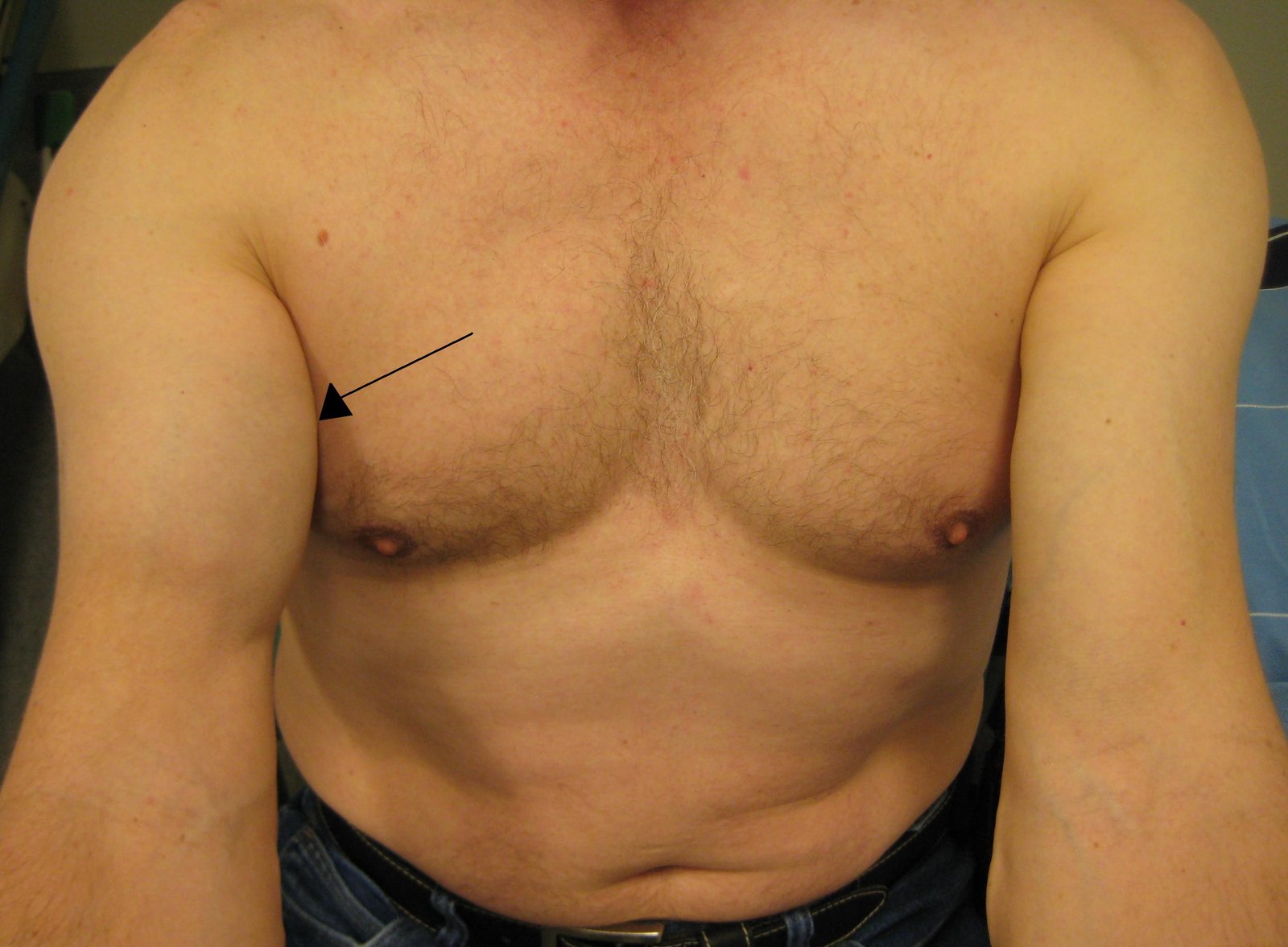Physical Therapist’s Guide to Biceps Tendon Rupture A biceps tendon rupture occurs when the biceps muscle is torn from the bone at the point of attachment (tendon) to the shoulder or elbow. Most commonly, the biceps tendon is torn at the shoulder. These tears occur in men more than women; most injuries occur at 40
Physical Therapist’s Guide to Biceps Tendon Rupture
 A biceps tendon rupture occurs when the biceps muscle is torn from the bone at the point of attachment (tendon) to the shoulder or elbow. Most commonly, the biceps tendon is torn at the shoulder. These tears occur in men more than women; most injuries occur at 40 to 60 years of age due to chronic wear of the biceps tendon. In younger individuals, the tear is usually the result of trauma (such as an auto accident or fall). Biceps tendon ruptures can also occur at any age in individuals who perform repetitive overhead lifting or work in occupations that require heavy lifting, and in athletes who lift weights or participate in aggressive contact sports.
A biceps tendon rupture occurs when the biceps muscle is torn from the bone at the point of attachment (tendon) to the shoulder or elbow. Most commonly, the biceps tendon is torn at the shoulder. These tears occur in men more than women; most injuries occur at 40 to 60 years of age due to chronic wear of the biceps tendon. In younger individuals, the tear is usually the result of trauma (such as an auto accident or fall). Biceps tendon ruptures can also occur at any age in individuals who perform repetitive overhead lifting or work in occupations that require heavy lifting, and in athletes who lift weights or participate in aggressive contact sports.
Physical therapists help individuals regain flexibility, strength, and function in their arms following biceps tendon ruptures.
What is a Biceps Tendon Rupture?
The shoulder is a ball-and-socket joint made up of 3 bones: the upper-arm bone (humerus), the shoulder blade (scapula), and the collar bone (clavicle). The ball at the top of the upper-arm bone is called the head of the humerus. The socket on the shoulder blade is called the glenoid fossa. A tendon is a fibrous bundle that attaches a muscle to a bone. The muscles and tendons of the rotator cuff hold the ball into the socket of the shoulder. The biceps muscle has 2 tendons that attach it to the shoulder and travel the length of the upper arm and insert just below the elbow. The biceps muscle is responsible for bending (flexing) the elbow and rotating the forearm. One of the tendons is called the “long head” of the biceps muscle; it attaches to the upper-arm bone. The second area of attachment is called the “short head” of the biceps; it attaches the muscle to a bony bump on the shoulder blade called the coracoid process.
Most commonly, the biceps tendon will tear at the long head of the biceps at the upper-arm bone, leaving the second attachment at the shoulder blade intact. The arm can still be used after this type of rupture, yet weakness will be present in the shoulder and upper arm. A tear can either be partial, when part of the tendon remains intact and only a portion is torn away from the bone, or complete, where the entire tendon is torn away from the bone.
How Does it Feel?
After sustaining a biceps tendon rupture, you may experience:
- Sharp pain in the upper arm or elbow
- Hearing a “pop” or snap at the shoulder or elbow
- Bruising and swelling in the upper arm to elbow
- Weakness in the arm when bending the elbow, rotating the forearm, or lifting the arm overhead
- Tenderness in the shoulder or elbow
- Muscle spasms in the shoulder and arm
- A bulge or deformity in the lower part of the upper arm (a “Popeye arm”)
How Is It Diagnosed?
In most cases, a thorough history and physical examination of the involved arm can diagnose a biceps tendon rupture. Your physical therapist will ask you several questions regarding your medical history, your regular daily tasks at home and at work, and your recreational or sports activities. Your physical therapist will ask how the injury happened and where you are having pain and/or weakness.
Your physical therapist will examine your entire upper arm for bruising or swelling, and gently touch it to determine if there is any tenderness over the biceps region at the shoulder, upper arm, or elbow. Your physical therapist also will examine the amount of motion and strength present on the involved side in the shoulder, forearm, and elbow, compared to the noninvolved side. Functional testing may also be performed to determine what daily tasks are difficult for you to perform (eg, lifting an object, reaching overhead, reaching behind the body, or rotating the forearm to open a door).
How Can a Physical Therapist Help?
A biceps tendon rupture often is treated without surgery. Your physical therapist will design an individualized treatment program to help heal your injury in the safest and most efficient way possible. Treatment may include:
Rest. You will be instructed in ways that allows the limb to rest to promote healing.
Icing. Your physical therapist will show you how to apply ice to the affected area to manage pain and swelling.
Range-of-Motion Activities. Your physical therapist will teach you gentle mobility exercises for the shoulder, elbow, and forearm, so your arm does not get stiff during the healing process.
Strengthening Exercises. As the pain and swelling ease, gentle strengthening exercises with resistant bands or light weights will be added.
Functional Activities. You will learn exercises to help you return to the activities you performed before the injury.
Education. Your physical therapist will teach you how to protect your joints from further injury. You will learn how to properly lift objects once the arm is healed, and how to avoid lifting objects that are simply too heavy.
Can this Injury or Condition be Prevented?
To prevent a biceps tendon rupture, individuals should:
- Maintain proper strength in the shoulder, elbow, and forearm.
- Avoid repetitive overhead lifting and general overuse of the shoulder, such as performing forceful pushing or pulling activities, or lifting objects that are simply too heavy. Lifting more than 150 pounds can be dangerous for older adults.
- Use special care when performing activities, such as lowering a heavy item to the ground.
- Avoid smoking; it introduces carbon monoxide into the body and leaves less oxygen for the muscles to grow and heal.
- Avoid steroid use, as it weakens muscles and tendons.
Real Life Experiences
Ryan is a 59-year-old man who owns and manages his own construction company. For many years, he has also participated in recreational weightlifting. Seven months ago, Ryan injured his neck when lifting weights and underwent neck fusion surgery to stabilize the bones in his neck. He returned to his job when his surgeon said it was safe to do so.
Last week at work, Ryan was helping a worker lift a granite countertop, when he felt a sharp pain and heard a “pop” in his left shoulder. That same day, he went to see his doctor, who diagnosed a biceps tendon rupture at the shoulder. Fortunately, surgery was not required. His doctor recommended physical therapy.
Ryan’s physical therapist performed a thorough evaluation of his left arm. She asked how the injury happened, how much pain he was in, and what activities he planned to return to after he recovered. She measured the amount of swelling in the arm and how much motion he had in his shoulder, elbow, and hand.
Ryan’s physical therapist helped him perform range-of-motion exercises at the shoulder and elbow. She also showed him how to use ice and elevate his left arm to help reduce swelling. She taught him a few gentle range-of-motion exercises to perform daily to keep his shoulder, hand, and wrist moving, so they wouldn’t become stiff. She cautioned Ryan to avoid lifting anything heavier than a coffee cup, to ensure proper healing.
After a few weeks of treatment, Ryan’s physical therapist taught him to perform gentle exercises to move his shoulder in all directions. She designed an individualized home-exercise program for him to keep his shoulder gently moving.
The following week, Ryan’s physical therapist noted that full range-of-motion had returned to his shoulder, and his pain and swelling had decreased. She helped him begin to use weights (5 pounds or lighter) to rebuild his shoulder strength.
After close to 3 months of treatment, Ryan was able to begin using heavier weights to strengthen his elbow, but his physical therapist told him that he could not perform any heavy lifting (more than 20 pounds) for at least 6 months. When he finished his formal physical therapy treatments, she gave him a comprehensive home-exercise program to complete on his own.
Today, Ryan has gradually resumed all his activities of daily living and has returned to work with a new awareness of the dangers of heavy lifting. He looks forward to resuming his workouts at the gym, performing safe exercises prescribed by his physical therapist.
What Kind of Physical Therapist Do I Need?
All physical therapists are prepared through education and experience to treat biceps tendon ruptures. However, you may want to consider:
- A physical therapist who is experienced in treating people with shoulder and elbow conditions or injuries. Some physical therapists have a practice with an orthopedic or sports medicine focus.
- A physical therapist who is a board-certified clinical specialist or who completed a residency or fellowship in orthopedic physical therapy. This therapist has advanced knowledge, experience, and skills that may apply to your condition.
You can find physical therapists who have these and other credentials by using Find a PT, the online tool built by the American Physical Therapy Association to help you search for physical therapists with specific clinical expertise in your geographic area.
General tips when you’re looking for a physical therapist (or any other health care provider):
- Get recommendations from family and friends or from other health care providers.
- When you contact a physical therapy clinic for an appointment, ask about the physical therapists’ experience in helping people who have underlying Alzheimer disease.
- During your first visit with the physical therapist, be prepared to describe your symptoms in as much detail as possible, and say what makes your symptoms worse.
Further Reading
The American Physical Therapy Association (APTA) believes that consumers should have access to information that could help them make health care decisions and also prepare them for their visit with their health care provider.
The following articles provide some of the best scientific evidence related to physical therapy treatment of bicep tendon ruptures. The articles report recent research and give an overview of the standards of practice both in the United States and internationally. The article titles are linked either to a PubMed* abstract of the article or to free full text, so that you can read it or print out a copy to bring with you to your health care provider.
Giacalone F, Dutto E, Ferrero M, Bertolini M, Sard A, Pontini I. Treatment of distal biceps tendon rupture: why, when, how? Analysis of literature and our experience. Musculoskelet Surg. 2015;99 Suppl 1:67–73. Article Summary in PubMed.
Ward JP, Shreve MC, Youm T, Strauss EJ. Ruptures of the distal biceps tendon. Bull Hosp Jt Dis (2013). 2014;72(1):110–119. Article Summary in PubMed.
Lorbach O, Kieb M, Grim C, Engelhardt M. Proximal and distal rupture of the m. biceps brachii [article in German]. Orthopade. 2010;39(12):1117–1122. Article Summary in PubMed.
Medscape. Epidemiology. Accessed November 30, 2015.
Medscape. Surgical intervention. Accessed November 30, 2015.
*PubMed is a free online resource developed by the National Center for Biotechnology Information (NCBI). PubMed contains millions of citations to biomedical literature, including citations in the National Library of Medicine’s MEDLINE database.
Authored by Julie A. Mulcahy, PT, MPT. Reviewed by the MoveForwardPT.com editorial board.44







Leave a Comment
You must be logged in to post a comment.